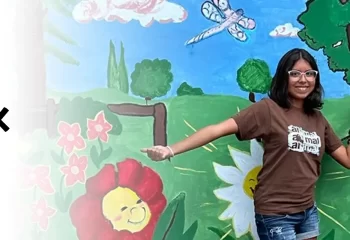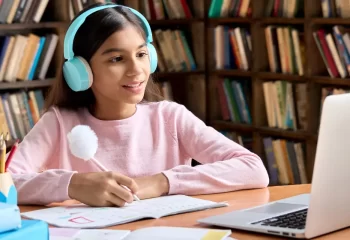Nowadays, Hybrid has been a common word in our daily vocabulary ever since Covid-19 happened. Hybrid cars, Hybrid working, hybrid learning, and hybrid teaching are only a few of the topics we run into lately, and there is a reason for it. It seems like the Hybrid movement is part of an ongoing innovation journey taking us closer to the future.
Just like our ancestors adapted to discovering fire and learning how to communicate, we adapted to a new way of living that’s doable whether or not we can be physically together. But how does hybrid learning work in high school?
At Spark Hybrid High School, we wanted to create a learning model that ensured different learning styles for families that no longer felt like the traditional high schools were meeting their needs. And we adopted the hybrid learning model to tackle this issue.
What does the hybrid learning model look like?
At Spark Hybrid High School, the hybrid learning model is a mix of online and offline learning split into an 80/20 formula. Digital learning accounts for 80% of the Spark high school experience, while in-person learning accounts for 20%.
While the split of online and offline parts might differ from high school to high school, one thing is certain. Today’s families need and appreciate the flexibility provided by hybrid high schools as it allows them to have unique lifestyles without compromising their children’s education.
That being said, Spark Hybrid High School has no typical day or week. Because of the flexibility the hybrid schooling offers, students can personalise their learning schedule as they see fit.
Want to complete that maths tutorial from your backyard at 9 PM? Totally fine. Have to be in a different country for a sports competition? No worries, tutorials and meetings can be moved around so they fit around YOUR schedule and needs.
The difference between hybrid high schools and traditional high schools
Traditional high schools usually have an admission period around summer, when students can register for the upcoming school year. Which generally also starts at the end of summer or the start of fall.
Spark Hybrid High School’s admissions period is as flexible as the learning environment. Meaning that students can enrol at any time of the year without having to rely on admission periods.
The mix of active and passive learning styles allows students to customise their learning by choosing when, what, where and how they learn. They also have the flexibility to take their Cambridge International Examinations whenever they feel ready, with varying yearly exam schedules.
When it comes to the subjects they learn, students at Spark Hybrid High School can choose between any of the 55+ Cambridge Self-paced courses created around how their brains learn. The subjects can vary from Geography to Law or Computer Science, and students are usually guided at the beginning of their high school journey to discover the topics that match their interests and goals best.
In traditional classrooms, teachers often must progress through the curriculum even if students haven’t fully understood the material. The hybrid learning model, however, allows students to slow down their learning when needed and advance in other subjects when they can.
Hybrid Learning Styles
Hybrid High Schools, as mentioned earlier, are a blend of online and in-person learning that students can benefit from to match their learning needs. Compared to traditional schooling, where students learn in a classroom environment, hybrid learning promotes authenticity.
Among some out-of-the-box learning styles used at Spark, we can mention Peer 2 Peer learning, Project-based learning, Student-led learning, etc.
Peer-to-peer learning, for example, is a learning style based on students teaching each other. Adolescents will often consider a colleague’s opinion or thoughts sooner than an adult’s (teacher or parent). If teenagers use this power to fuel each others’ interests and curiosities, this learning style can accelerate their understanding and learning process while helping them develop collaborative skills.
Project-based learning is another collaborative learning method involving hands-on experimentation from students. We all know that we learn things faster by doing than by having something presented to us. This learning method is supposed to prepare students for solving real-world problems while teaching them skills like adaptability and flexibility.
Unlike traditional teaching, classes and tutorials in a hybrid high school are more personalised. On some occasions, students will have access to 1:1 tutoring with their tutors, while on other occasions, they will participate in small group discussions to solve an issue or learn something new – there is never a boring way to teach a subject at Spark School.
The offline part of hybrid schooling
If we are talking about hybrid, we also need to focus on the offline part of the learning. There will likely be subjects like Chemistry or Biology that require labs or in-person activities to be completed for students to understand the learning materials fully. These offline experiences are usually conducted at local schools or learning hubs, and the families and students have the chance to find locations that are most convenient for them.
Exams also require an offline commitment from the student and their families. In the exam period, families enrolled in Spark are guided to discover the available exam centres near them and decide on what exams their teenagers will take part in.
Apart from these mandatory activities that require in-person commitments, there are other types of offline activities that students and their families can participate in.
For example, Spark Hybrid High School is part of the Duke of Edinburgh’s Award Program network and encourages students to participate and strengthen their volunteering ambitions while learning valuable life skills through this program.
Moreover, hybrid high schools should always look for ways to engage students and their families and create a feeling of community. For this reason, Spark Hybrid High School is looking to create more opportunities for engagement. To name some: social challenges, local pop-up hubs, conferences, exchange programs, or meet-ups.
Advantages of Hybrid High Schools
Some of the main advantages of hybrid high schools are:
- Freedom to travel and see the world without location boundaries
- Flexibility to create your own schedule
- Opportunities to interact with colleagues from around the world
- The chance to focus your schooling around the subject you find useful
- Power to prioritise between schooling and passion
- Different approaches to learning
- Personalised learning approach tailored to your needs
- More focus on you as a person rather than just one of many students in a classroom
- Tailored schooling plans that match your future goals
These are just some things that came to our mind when thinking about Spark Hybrid High School. But we can guarantee that there is more than meets the eye.
In the same context, the advantages listed above might also serve as disadvantages to some of us. For example, some families with rigid work schedules might prefer to know precisely when and where their teenager will be during school hours or how they are spending their time.
While it might be a burden to some, this rigidity is still normal for many of us. Not everyone should feel trapped, and not everyone will feel the need for a more flexible approach to education.
Spark is here to be the solution for those overwhelmed by rigidity and tradition. We aim to break the boundaries of traditional classrooms and embrace future readiness. To offer a safe place for those who dare to learn differently.
How do you know a hybrid high school fits your needs?
For some, hybrid learning might be the way, but it does not have to be for everyone. If you feel like you might be trapped in your educational journey and would like to test out different approaches to learning, we would love to hear from you.
Here’s what one of our students said about the flexibility offered by our hybrid schooling model:
“…What I like most about Spark is the freedom to study at my own level, which is crucial for any kind of performance. The fact that I can choose what subjects to study helps me focus more on my most important passion, mathematics. Spark also allows me to learn things applicable to real life and focuses on developing every student as a whole.”
Alexandru D (also known as Tashi) – year 11 Spark Student
Apart from our full-time high school experience, we also offer Cambridge Accredited Courses at Spark (with or without a tutor). These are for those who would like a taste of our hybrid learning environment but are not ready to commit.
Make the first step towards an international education today. Invest in a future paved with quality knowledge at Spark.




